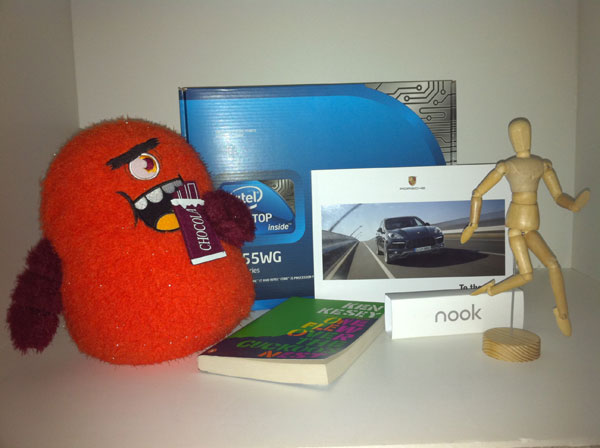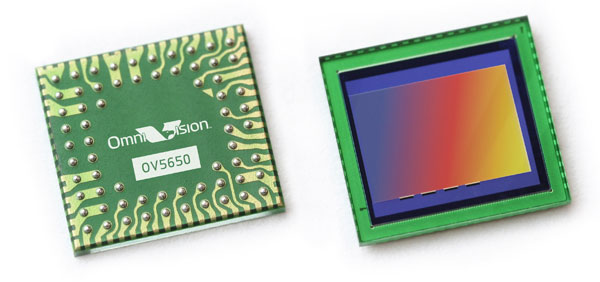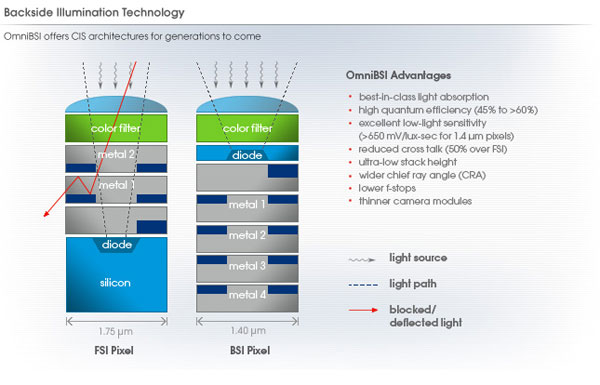Apple's iPhone 4: Thoroughly Reviewed
by Brian Klug & Anand Lal Shimpi on June 30, 2010 4:06 AM EST- Posted in
- Smartphones
- Apple
- iPhone 4
- Gadgets
- Mobile
Welcome to 2010, Apple Upgrades its Camera
The iPhone 4 is equipped with two cameras: a 5 megapixel camera with LED flash on the back of the phone and a VGA camera with no flash on the front. The LED flash works in both still and video modes. Like the EVO 4G, the iPhone 4‘s flash allows you to shoot in perfect darkness. If you’re filming a video in low light the LED will stay illuminated while you’re recording.

Taken with the iPhone 4 in total darkness
The same unfortunately can’t be said for the front facing camera on the 4. In anything but good lighting you’re going to get noise. It’s really only useful for FaceTime (or as an alternative to a mirror) and even then you need to be well lit for it to look decent.
Apple has opted for a 5 megapixel OmniVision sensor for the rear camera on the iPhone 4. What's interesting is that Apple has decided to bring backside illumination front and center with their marketing.
Backside illumination improves the sensitivity of CMOS and CCD detectors by reducing the amount of material in the path of incident light. In a frontside illuminated detector, a considerable amount of light is lost due to absorption that doesn't result in emission of an electron, in addition to reflection off pixel structures and electrical components near the frontside surface. Backside illumination greatly improves sensitivity by flipping the stack over. Instead of light having to pass through and possibly be reflected by metal structures, it is converted into electrons and read out by passing solely through silicon. Creating a backside illuminated part isn't as simple as flipping a sensor over, however, as manufacturers also generally thin the silicon light has to pass through before it can reach the photodiode. This further improves sensitivity and is generally accomplished through chemical etching in acid or by lapping (physically grinding) sensors at wafer scale.

OmniVision OV5650 - iPhone 4's rear camera SoC
Though backside illumination (BSI) improves quantum efficiency (how many photons are converted into electons), backside illumination is hugely important for another serious reason as well. Because the sensor is small at 4.6 mm by 3.4 mm, pixel size is also extremely small at just 1.75 microns square for the OV5650 in the iPhone 4 (state of the art sensors are 1.4 microns square, like those in the HTC Incredible's 8 MP sensor). Frontside illuminated parts generally have in the neighborhood of 10-15 microns of silicon before the active region of the photodiode where one wants photons to get converted to electrons. The result is that without backside illumination, pixels have a 10:1 ratio of height to length, you can visualize them as looking something like long square pillars. But that's a problem.
As photons are converted into electrons in that silicon, there's no guarantee that it will immediately travel down into the gate structure below to be read out by the camera. Electrons drift as they descend these columns, meaning that photons incident on one pixel don't necessarily map to the gate below. Because the smartphone camera sensors are so small, with a 10:1 ratio of height to size, the result is large amounts of so-called quantum blurring from electrons traveling into the gate structures of adjacent pixels. The result is a blurry image (and a decrease in MTF at the sensor level!), thus not representing the image that used to be incident on the sensor.
OmniVision and other smartphone CMOS sensor manufacturers thin that column down in an effort to come closer to having the pixel look more like a cube than a huge pillar. Ballpark numbers are between 3 and 6 microns, down from 10-15. The result is much more sensitive sensors that are higher resolution. While megapixels don't necessarily matter, neither does pixel size as much anymore; it's all about quantum efficiency, which is what engineers really care about.

OmniVision BSI - Courtesy OmniVision
The optical system of the iPhone 4 is difficult to characterize without disassembly, though the focal length is a bit shorter than previous iPhones. The result is that the photos are demonstrably wider angle. Backside illumination also allows for a bigger chief ray angle, higher numerical aperture (and thus lower f/#), but I won't bore you with the details.










270 Comments
View All Comments
Belard - Friday, July 2, 2010 - link
On the back of all iPhones... whats with the ugly logos on the back of the phones?I don't know another phone that has such things and you'd think on a style-brand such as Apple, they really would work to NOT put such things on.
Look at the HTC-EVO review. Other than HTC & Sprint logos, its all nice and clean looking.
My SONY phones... only say Sony. Even the bottom of my Logitech mouse only has a CE logo and product text "DUAL LASER".
mikelward - Friday, July 2, 2010 - link
The Nexus One photos looked much better to me. The iPhone 4 was too yellow and the Evo was too noisy.Out of interest, is this something that could be fixed in a firmware update, and what version of Android was the N1 running?
Thank you very much for the review, especially the antenna section.
QuantumForce - Friday, July 2, 2010 - link
Did you average dBs as if they were linear numbers? Really? They are a log transform of a ratio between measured and standard linear intensity or pressure. 20 dB * 2 is not equal to 40 dB. Just how did you deal with the math here in your sample analysis of six readings?
metalev - Friday, July 2, 2010 - link
I re-charted the signal strength quoted in this article to make the huge signal strength range given to 5 bars much more obvious:http://www.metalev.org/2010/07/apple-caught-red-ha...
KOTULCN - Saturday, July 3, 2010 - link
You said you restored your iPhone 4 to a back-up of a jail broken 3.1.3? Alittle bit more explanation is due!MrBrownSound - Saturday, July 3, 2010 - link
Very detailed review. In the end with Froyo coming I'd have to choose Evo no matter the extended wait because of integration with sense UI. Although I will have to compromise battery life, stunning display and sheer expensive look and feel compared to the iphone. To make up for it I will be able to make calls, have a bigger screen, and also have the all open android OS. trade-offs trade-offs. I'll take it over being locked to at&t for two years with three hundred something termination fee.Again very thorough review. This is why i read Anandtech
spiritu - Saturday, July 3, 2010 - link
I note that some subtle but significant changes have been made to your article since it was first published.In particular, the following line:
It originally said:
"Apple should add an insulative coating to the stainless steel band (which implies a recall), or subsidize bumper cases." (which implies apple should pay for the cost of the bumper)
Now it says:
"The most sensitive region of the antenna should have an insulative coating (next time round?), or everyone should use a case. (which implies the user should buy a bumper).
I can only presume that you made these changes under duress.
orangpelupa - Saturday, July 3, 2010 - link
great review. very in-depth. Nice knowing what the reason behind iPhone 4 "signal problem".btw
seeing this
http://images.anandtech.com/doci/3794/iPhone4-3422...
i got struck by nostalgic feeling :D
it really looks like my 4 years old cellphone. (now its dead lol)
Sony Ericsson M600i.
http://img23.imageshack.us/img23/9964/030720101018...
the "sides" design really remind me of my old phone :)
drwho9437 - Saturday, July 3, 2010 - link
"The Antenna is Improved" is a subheading. The content is more or less fine, but it shouldn't be called the Antenna is improved. If the software is correctly reporting the number of dBm and it just works at lower levels because of a lower noise floor in the RF amplifier, then you should say "reception is Improved" or something.The improvement in the signal is down to the mixer, amp or filters not the antenna gain as you note from your dBm level measures.
Axelband - Saturday, July 3, 2010 - link
This is simply the best and most thorough product review I have ever read. It had just enough technical information to satisfy an engineer like me but not too much to bore a layman. Bookmarking your site now.